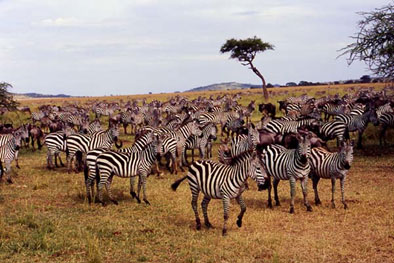
Source: Zebra Herd, Travel.neunerweb.de

Source: Zebra Herd, Travel.neunerweb.de
The picture to the right shows a herd of zebra in Tanzania, Africa. These zebra, like all living things, need food, water, shelter, and space to survive and will compete with each other and other species of animals for these biotic and abiotic factors. As long as they have all of these things available to them, their population will continue to grow. However their populations cannot grow forever. In any ecosystem, there is only a certain amount of food, water, living space, mates, and other resources. The ecosystem can only support a certain number of individuals. When there are not enough resources, the number of individuals in the population is limited. Resources that limit population growth are called limiting factors. Limiting factors prevent the population from getting too large. When the population stops growing, the ecosystem has reached its carrying capacity. Carrying capacity is the largest number of individuals of one species that an ecosystem can support over time. If a population exceeds the carrying capacity, some individuals will not have enough resources and will die or move to another location.
![]() Use the interactive below to learn more about limiting factors and ecosystems.
Use the interactive below to learn more about limiting factors and ecosystems.
If we graph the size of a population over time, we can easily see the carrying capacity of the environment. Study the simplified graph below. Can you determine what the carrying capacity is? Hint: look for the place on the graph to see where the population levels off and then fluctuates.
What is the carrying capacity of this environment? Click on the graph to see.
Interactive popup. Assistance may be required. The carrying capacity would be 9. The red line shows the carrying capacity.